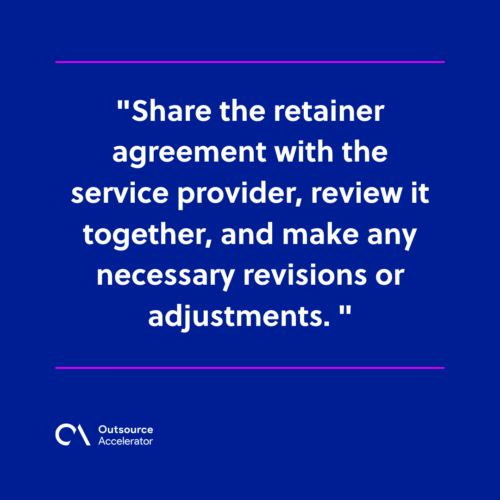Monthly retainers and how they work

As the business landscape evolves, so does how we conduct transactions and pay for services. One popular method of payment is the monthly retainer.
According to FasterCapital, monthly retainers can be valuable for those needing consistent support and guidance.
So whether you’re a freelancer, consultant, or a business owner seeking specialized services, understanding how this method works can be a game-changer.
This guide delves deep into monthly retainers, what they are, and how they work. We’ll also discuss how to set them up and manage them effectively.
What is a monthly retainer?
A monthly retainer is an agreement between a client and a service provider where the client pays a fixed fee every month in exchange for a set of services.
This arrangement provides the client with a dedicated resource or team for a specific period. It allows them to access the expertise and assistance they need on an ongoing basis.
Monthly retainers are commonly used in various industries, including marketing, legal services, and consulting.
For example, a marketing agency might offer a monthly retainer to provide clients with content creation, social media management, and advertising services.

How does a monthly retainer work?
When it comes to how a monthly retainer works, transparency and clear communication are key.
The client and service provider should establish the following at the beginning of the agreement:
- Clear expectations
- Deliverables
- Terms of service
Additionally, setting it up requires both parties to discuss:
- The scope of work
- The number of hours or deliverables included
- Any additional costs or limitations
This ensures that the client understands exactly what they are paying for and what they can expect from the service provider.
Once the retainer agreement is in place, the client typically pays the fee at the start of each month.
In return, the service provider commits to the agreed-upon services within the designated time frame. This gives the client a predictable budget and access to the necessary services throughout the month.
How to set up a monthly retainer
To effectively set up a monthly retainer for your organization, follow these steps:
1. Identify the services
Clearly define the specific services that your organization requires on an ongoing basis. Identify the tasks, projects, or support you need from the service provider.
2. Determine the scope
Establish the extent of the services you require. Will you need a dedicated resource available for a fixed number of hours? Discuss any limitations or exclusions to ensure both parties are aligned.
3. Establish the pricing
Calculate a fair and competitive monthly fee that adequately compensates the service provider for their time and expertise. Research market rates and consider the complexity of the services being provided.
4. Create a retainer agreement
Draft a written agreement that outlines all the details of the retainer. Include the scope, deliverables, fees, payment terms, and any extra terms and conditions.
5. Review and finalize
Share the retainer agreement with the service provider, review it together, and make any necessary revisions or adjustments. Both parties should have a clear understanding and agreement before signing.

How to calculate monthly retainer fee
When calculating the monthly retainer fee, let’s first understand the two types:
Earned retainer fees vs. Unearned retainer fees
Earned retainer fees are payments made in exchange for services provided or completed within a particular billing period. These are typically non-refundable and reflect the actual work done by the provider.
On the other hand, unearned retainer fees are advanced payments for services to be rendered in the future. These are held in a separate account and are recognized as revenue only when the services are performed.
Understanding the distinction between the two is crucial for accurate financial reporting and ensuring transparency.
Calculating monthly retainer fees
Calculating the monthly retainer fee involves considering several factors. This is to ensure it appropriately reflects the value the service provider brings:
- Time and expertise. Evaluate the amount of time and level of expertise the service provider will dedicate to fulfilling your organization’s needs. Consider the complexity of the tasks or projects involved.
- Market rates. Research market rates for similar services in your industry to ensure the fee is competitive and aligns with prevailing standards.
- Unique value. Assess the unique value the service provider brings to your organization. It may warrant a premium fee if they possess specialized skills or extensive experience that sets them apart.
- Expenses. Consider any expenses or overhead costs the service provider will incur while delivering the services. Ensure their costs are adequately covered to preserve profitability.
Tips for managing a monthly retainer
To effectively manage a monthly retainer for your organization, consider the following tips:
- Regular communication. Maintain open lines of communication with the service provider to discuss progress, challenges, and any changes that may arise.
- Track utilization. Keep track of the services utilized from the retainer to monitor their effectiveness and ensure the organization’s needs are being met.
- Value-driven approach. Foster a strong partnership by consistently delivering high-quality work and going the extra mile. Ensuring an ongoing positive impact and added value will solidify the trust between both parties.
- Regular review and feedback. Regularly review the retainer agreement and overall performance to identify opportunities for improvement or revisions.
Monthly retainers are more than just a financial arrangement — they are a blueprint for collaborative success.

By understanding their nature, businesses and service providers can cultivate enduring partnerships that stand the test of time.
As you leverage monthly retainers, remember that success lies in the delicate balance between structure and adaptability, transparency, and communication.







 Independent
Independent




